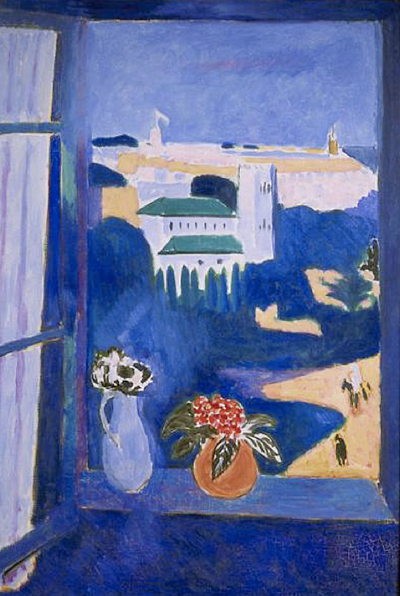North Africa has been used as the backdrop for a number of famous paintings from western artists over several centuries. In this piece, Matisse captures a cityscape view of Tangiers in Morocco and uses his signature style of bright colour and reduced details.
Several artists in the 19th and 20th centuries would capture scenes from behind a window, adding an extra dimension to just including the landscape itself. This allowed the viewer to feel as if they were in their own home, looking across a cityscape of Tangiers, in this example. Matisse here includes a simple but bright window ledge in bold tones of blue and adds some charming potted flowers. It gives a homely a warm theme to the overall piece.
Blues continue to flood the rest of the scene, whilst the artist places a couple of people in the foreground in order to add a feeling of scale. The buildings of this town stand out in their pure white tones. This helps capture the style of this typical North African architecture. There are then some additional touches of green and yellow in order to add further interest to Matisse's minimal use of detail.
Matisse also produced several other paintings from behind a window, including Open Window, The Blue Window and Harmony in Red. Another related artist to take on this challenge was Gustave Caillebotte who produced some memorable scenes of Paris, often looking out over its boulevards. An alternative idea was used by German Romanticist painter, Casper David Friedrich who would place individuals in the foreground of his paintings, looking out over the landscape.
Matisse was one of several artists to become intrigued by Islamic art and visited Morocco itself in 1912 and then again in 1913. This particular painting was completed during his first visit and displays his consistent use of a flat perspective, something that was still a relatively new idea at this point. Despite his particularly modern approach, Matisse was still able to gain success and acclaim during his own lifetime, counting upon several well established donors and also some notable connections within the European art industry.
You can find plenty more art to enjoy at the Pushkin Museum of Fine Arts in Moscow, Russia. Followers of Matisse can also find more of his work across in St Petersburg, whilst more general followers of famous artists from across the centuries might also enjoy further highlights in the collection of the Pushkin Museum of Fine Arts, such as Fastnacht (Mardi Gras) by Paul Cézanne, The Red Vineyard by Vincent van Gogh, Blue dancers by Edgar Degas and Portrait of actress Jeane Samary by Pierre-Auguste Renoir.




